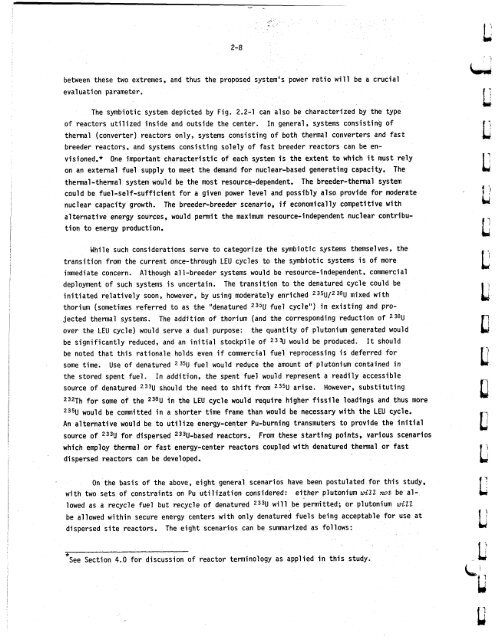ORNL-5388 - the Molten Salt Energy Technologies Web Site
ORNL-5388 - the Molten Salt Energy Technologies Web Site
ORNL-5388 - the Molten Salt Energy Technologies Web Site
Create successful ePaper yourself
Turn your PDF publications into a flip-book with our unique Google optimized e-Paper software.
2-8<br />
between <strong>the</strong>se two extremes, and thus <strong>the</strong> proposed system's power ratio will be a crucial<br />
evaluation parameter.<br />
The symbiotic system depicted by Fig. 2.2-1 can also be characterized by <strong>the</strong> type<br />
of reactors utilized inside and outside <strong>the</strong> center. In general, systems consisting of<br />
<strong>the</strong>rmal (converter) reactors only, systems consisting of both <strong>the</strong>rmal converters and fast<br />
breeder reactors, and systems consisting solely of fast breeder reactors can be envisioned.*<br />
One important characteristic of each system is <strong>the</strong> extent to which it must rely<br />
on an external fuel supply to meet <strong>the</strong> demand for nuclear-based generating capacity. The<br />
<strong>the</strong>rmal-<strong>the</strong>rmal system would be <strong>the</strong> most resource-dependent. The breeder-<strong>the</strong>rmal system<br />
could be fuel-self-sufficient for a given power level and possibly also provide for moderate<br />
nuclear capacity growth. The breeder-breeder scenario, if economically competitive with<br />
a1 ternative energy sources, would permit <strong>the</strong> maximum resource-independent nuclear contribu-<br />
tion to energy production.<br />
While such considerations serve to categorize <strong>the</strong> symbiotic systems <strong>the</strong>mselves, <strong>the</strong><br />
transition from <strong>the</strong> current once-through LEU cycles to <strong>the</strong> symbiotic systems is of more<br />
immediate concern. A1 though a1 l-breeder systems would be resource-independent, commercial<br />
deployment of such systems is uncertain. The transition to <strong>the</strong> denatured cycle could be<br />
initiated relatively soon, however, by using moderately enriched 235U/2 38U mixed with<br />
thorium (sometimes referred to as <strong>the</strong> "denatured 23sU fuel cycle") in existing and projected<br />
<strong>the</strong>rmal systems. The addition of thorium (and <strong>the</strong> corresponding reduction of 238U<br />
over <strong>the</strong> LEU cycle) would serve a dual purpose: <strong>the</strong> quantity of plutonium generated would<br />
be significantly reduced, and an initial stockpile of 23% would be produced. It should<br />
be noted that this rationale holds even if commercial fuel reprocessing is deferred for<br />
some time. Use of denatured 23% fuel would reduce <strong>the</strong> amount of plutonium contained in<br />
<strong>the</strong> stored spent fuel. In addition, <strong>the</strong> spent fuel would represent a readily accessible<br />
source of denatured 233U should <strong>the</strong> need to shift from 23% arise. However, substituting<br />
232Th for some of <strong>the</strong> 23*U in <strong>the</strong> LEU cycle would require higher fissile loadings and thus more<br />
235U would be comnitted in a shorter time frame than would be necessary with <strong>the</strong> LEU cycle.<br />
An alternative would be to utilize energy-center Pu-burning transmuters to provide <strong>the</strong> initial<br />
source of 233U for dispersed 233U-based reactors. From <strong>the</strong>se starting points, various scenarios<br />
which employ <strong>the</strong>rmal or fast energy-center reactors coupled with denatured <strong>the</strong>rmal or fast<br />
dispersed reactors can be developed.<br />
On <strong>the</strong> basis of <strong>the</strong> above, eight general scenarios have been postulated for this study,<br />
with two sets of constraints on Pu utilization considered: ei<strong>the</strong>r plutonium wiZZ no& be allowed<br />
as a recycle fuel but recycle of denatured 233U will be permitted; or plutonium wiZZ<br />
be allowed within secure energy centers with only denatured fuels being acceptable for use at<br />
dispersed site reactors. The eight scenarios can be summarized as follows:<br />
* See Section 4.0 for discussion of reactor terminology as applied in this study.



![Review of Molten Salt Reactor Physics Calculations [Disc 2]](https://img.yumpu.com/21979492/1/190x247/review-of-molten-salt-reactor-physics-calculations-disc-2.jpg?quality=85)












